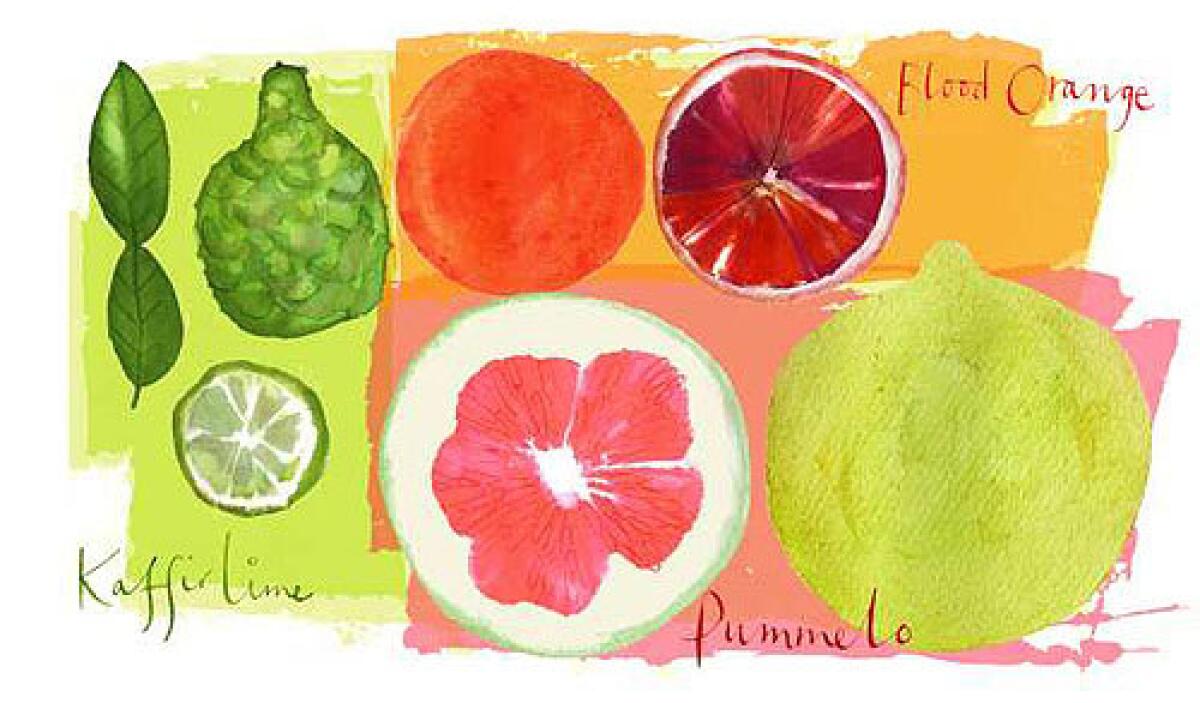Grow your own exotic citrus -- pummelos, blood oranges and kaffir limes.

SOUTHERN CALIFORNIA has the perfect climate for growing unusual citrus. Some of the more interesting include fruited blood oranges, fragrant-leaved kaffir limes and the surprisingly enormous pummelo.
Pummelo (Citrus maxima): It looks like an elephant version of a grapefruit. Those sold at farmers markets can have different shapes -- round, oval, even some with necks -- and come in shades of yellow or green outside, pink or yellow inside. Shop in the nursery, however, and you are most likely to encounter a pummelo called ‘Chandler,’ which has pink flesh and greenish-yellow or pink-blush-yellow skin.
‘Chandler’ are vigorous growers, reaching 20 to 22 feet tall and wide on standard rootstock and nearly 15 feet tall and wide on dwarf rootstock. Branches hang down slightly, especially when laden with ripe fruit from April through August.
Tracy Kahn, curator of the Citrus Variety Collection at UC Riverside, says ‘Chandler’ is a hybrid of two pummelos, one being the very low-acid ‘Siamese Sweet,’ which is also a parent of ‘Oroblanco,’ a pummelo-grapefruit cross (most often sold as grapefruit). Pummelos are popular throughout their native Asia. In China, for example, the fruits symbolize fortune and plenty. They are prized as part of the Chinese new year celebration.
‘Chandler’s’ white pith is an inch or so thick, depending on where the fruit is grown. In hotter, drier areas inland, pith tends to be thicker; in cooler and more humid areas along the coast, pith is thinner. To eat, peel and separate the segments. Then slice the membrane open to reveal the pale or deep pink, juice-filled vesicles -- the tasty treasures you’re after.
Blood orange (Citrus sinensis): The myth and lore that surround the rosy skin and deep-red flesh of a blood orange include accusations of poisoned trees and blood injected into fruits. One theory proposes that the fruit came from grafting a standard “blonde” orange to the rootstock of a pomegranate. It doesn’t seem that far-fetched if you consider the similarity of the two fruits’ shapes and colors.
But blood oranges arise neither from contamination nor from grafting. According to fruit specialist David Karp, they are the result of a spontaneous genetic mutation that is thought to have first occurred many centuries ago in blood oranges’ native China and repeated, perhaps several times, as oranges spread to Europe, the Mediterranean and eventually to the United States.
If you live where days are warm and dry and nights are cool, you have the perfect climate for the sweetest and deepest red-colored oranges. Along the coast, where the temperature is more moderated, blood oranges are markedly paler.
The three varieties offered by local nurseries all grow to about 15 to 18 feet tall and wide on standard rootstocks, 6 to 8 feet tall and wide on dwarf rootstock. You can keep them smaller with regular pruning or by growing them in containers. Be prepared for fruit color to vary from variety to variety, tree to tree, year to year and fruit to fruit. The size of crops can vary too, heavy one year, light the next.
As with all citrus, tree-ripened fruits taste best, but if left on the tree too long, blood oranges lose their flavor, says Daniel Nelson, director of nursery operations for La Verne Nursery in Piru, one of the area’s largest wholesale citrus growers. He says the best time to pick is when the fruit feels heavy and just about falls off into your hand.
‘Moro’ hails from Sicily and has the deepest-colored rind and flesh. Fruits ripen from January to May. At peak ripeness, the flesh is vermilion and more tart than a navel or ‘ Valencia.’ Left on the tree too long, the color becomes even darker, but as acids break down, the fruit starts to taste flat.
‘Tarocco’ is the largest variety. The thorny trees of this Sicilian blood orange yield fruits not quite as deep-colored as ‘Moro,’ but which are often described as the sweetest and best tasting.
‘Sanguinelli’ (also called ‘Spanish Sanguinelli’) has smaller fruits that are more oval than round. Rinds are blushed red and the flesh is moderately pigmented, often streaked.
Kaffir lime (Citrus hystrix): While most other citrus are valued for their flesh, kaffir lime is valued for its intensely fragrant leaves and rind. No Thai curry or tom yum goong soup is complete without the tangy aromatics of the leaf.
The leaves of this native of Indonesia and Malaysia are shiny green, each with two lobes. In fact, Spanish-speaking people call kaffir lime hoja de ocho for its figure-eight-shaped leaf.
It can take 10 years or more for a seed-grown kaffir to begin fruiting. Plants sold by nurseries are grafted so they should fruit within a year or two. The fruits are small and round, very warty and very pithy. They stay green for a few months then ripen to yellow. Most, however, are picked and used green.
The leaves can be harvested at any time of the year though most cooks prefer the young, soft leaves from the growth flushes of spring and mid- to late summer.
Dried leaves are available at the market, but fresh ones are that much more potent. Thailand native Cha Cha Wright of Encinitas picks fresh young leaves to freeze and cook with throughout the year.
More to Read
Sign up for our L.A. Times Plants newsletter
At the start of each month, get a roundup of upcoming plant-related activities and events in Southern California, along with links to tips and articles you may have missed.
You may occasionally receive promotional content from the Los Angeles Times.






